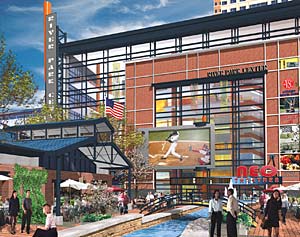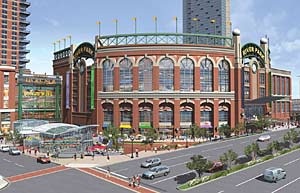Correction appended August 15, 2007
Cleaner than it’s been in decades, the Hudson River is a cynosure for residential developers, who value the profitable potential of its scenic vistas. The shores of Lower Manhattan were first to sprout high-rise condos, followed by Jersey City across the river. Now, 15 miles to the north, the former industrial powerhouse of Yonkers is transforming its disused Hudson waterfront and reclaiming another, much neglected waterway.

The city of Yonkers, New York, is uncovering sections of the Saw Mill River, which runs through its downtown district.

The reborn Saw Mill forms the heart of a $1.8 billion project called River Park Center, which includes residences, shops, a hotel, and office space.

River Park Center will also include a new 6,500-seat baseball stadium.
Following the model of Providence, Rhode Island, which uncovered its own river in the 1990s, Yonkers is unearthing and cleaning up three segments of the Saw Mill River, which has coursed largely unseen through subterranean pipes and culverts under the city’s center since the 1920s. Outdoor cafés and landscaped promenades will eventually line its banks. The first two segments, totaling one-fifth of a mile, will be completed in 2010.
The reborn Saw Mill forms the heart of a $1.8 billion project called River Park Center. Stuever Fidelco Cappelli, a partnership of local developers, is clearing 18 acres comprising eight blocks surrounding Getty Square, Yonkers’s historic center. More than 4 million square feet of condominiums, apartments, shops, a hotel, offices, parks, and a baseball stadium will start rising at the site in September. The designers include Ehrenkrantz Eckstut & Kuhn Architects, Clarke Caton Hintz, and Design Development.
River Park’s 6,500-seat stadium rests atop commercial space—home plate will be situated 100 feet above ground level—with two residential towers flanking it, providing residents with a bird’s-eye view of the action. “We wanted to stack all these different parts on top of each other to create synergy,” explains Mark Schulman, a principal of Design Development.
Other large-scale residential projects are already under way. They include Hudson Park North, which broke ground last winter on the site of a former lumberyard. The $125 million development is composed of two connected towers containing 294 apartments, and an esplanade that connects to a newly refurbished pier on the Hudson.
Do H. Chung and SCLE Architects designed Hudson Park’s residential portion: two towers, 12 and 14 stories, respectively, that bookend a row of lower-rise units. It’s a massive and dense project for the neighborhood—but some believe the city is due for a new look. “We are creating a new vernacular here because Yonkers was torn to shreds in the past 50 years,” says Arthur Collins, a principal of the project’s developer, Collins Enterprises.
Other designs are testing the city’s appetite for novelty. This much became clear at a public hearing in March, when British architect Wil Alsop unveiled his proposal to stack 400 apartments on top of a disused power plant on the Hudson. The scheme would require replacing a pair of brick smokestacks with a multicolored glass, 25-story tower perched on tentaclelike stilts. Neighbors objected that it is too tall.
Alsop defended his design by saying that the plant “will fall down if nobody does anything about it.” A side benefit, he added, will be that the scheme’s esplanade and café could help reconnect residents to the Hudson—and, in the end, “life comes down to eating, drinking, and feeling relaxed.”
Correction: New facts have come to light since the initial publication of this story. River Park Center will not break ground in September 2007, as we originally reported, because the project has not received necessary approvals yet. Stuever Fidelco Cappelli, the development entity, does not have possession of the land yet and municipal leaders are still determining which portions of the mixed-use development they might fund.

